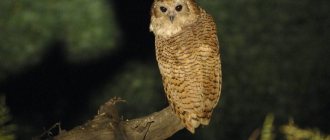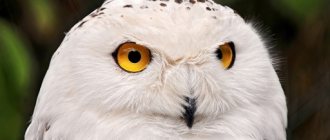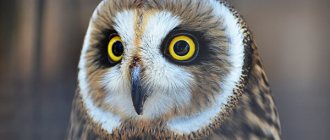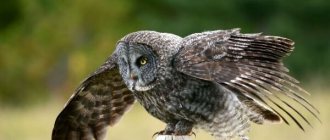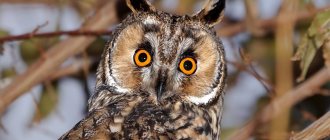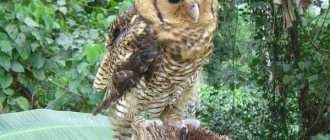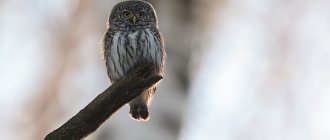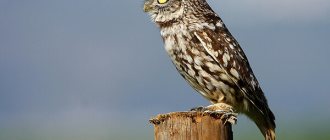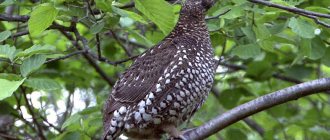Origin of the species and description
Photo: Polar owl
The polar owl, or as many people call it, the white owl, belongs to the genus of eagle owls, a family of owls of the order Owls. The bird received its second name for its white plumage, spread over the entire body. In the original classification, this species was included in a separate genus, but modern biologists believe that the polar owl belongs specifically to the genus of eagle owls.
According to paleontological data, the common ancestor of all owls lived about 80 million years ago. Certain species, including probably the polar owl, became widespread 50 million years before the appearance of humans. One of the proofs (but not the only one) of their antiquity is the fact that they are distributed on separated continents and have the same appearance, although the owls themselves never fly across the ocean.
Video: Polar owl
Features characteristic of all owls include the fact that they lack eyeballs, so their eyes are more similar in structure to spotting tubes. The eyes cannot move, but evolution compensated for this deficiency with the mobility of the head, which can turn almost a full turn around the neck (to be precise, 280 degrees - 140 in each direction). In addition, they have very sharp eyesight.
Owls have not two, but three pairs of eyelids, each of which performs its own function. One is needed for blinking, the other is to protect the eyes while sleeping, the other is used as car wipers to keep them clean.
Genus pygmy owls
Owls of this genus are small, their wings are short, and their tail feathers are long. The color is reddish-brown, with dark and light dots. Why not sparrows? There are as many as three dozen species of such “sparrows” within the genus.
Great Sparrow Owl
The only species of small owls living in Russia is the great owl. Its size is only from 150 to 200 mm and its weight is no more than 500-800 grams. The yellow eyes of the pygmy owl are surrounded by chocolate circles, and white eyebrows hang over the top.
Despite its modest size, the pygmy owl is a brave hunter. Boldly swoops down on living creatures equal in size to it - mice, rats, lemmings, partridges. The gourmet from the owl family immediately eats the brain and eyes of the victim, and stores the rest of the carcass in a hollow for a “rainy day.” The pygmy owl is also not lacking in cunning. In winter, it waits in ambush at feeders, lying in wait for titmice, sparrows and bullfinches.
Owls are also familiar with “swan loyalty.” They form a pair once in their entire life. While the chicks are hatching, the father owl touchingly feeds his female. A family nest nestles in an abandoned woodpecker nest.
Appearance and features
Photo: White polar owl
Compared to other tundra birds, the polar owl is very large. Its average wingspan is one and a half meters. The maximum known size reached 175 cm. Interestingly, this is one of the few species in which the females are larger than the males. In particular, their body length ranges from sixty to seventy centimeters, while the maximum size of the male is only 65 centimeters. The body weight of females is also greater - about three kilograms. Males weigh on average only two and a half kilograms.
The plumage of a snowy owl is very thick and quite warm. Even the legs are covered with thin feathers that look like wool. Small feathers also hide the bird's beak. This is due to living in fairly severe cold conditions. In addition, the owl's feathers have a special structure with a twist, thanks to which it is able to fly almost silently. Another feature is that the snowy owl moults with the changing seasons. She begins to shed her old plumage at the beginning of summer and for the second time a year - at the end of autumn.
The color, as you can already understand from the second name of the bird, is white. It fully corresponds to the habitat of the polar owl. Due to the fact that it blends into the snowy background, the owl remains invisible to predators and its victims. Scientifically, this coloring, corresponding to the background, is called protective. There are dark spots on the plumage. Their arrangement is unique to each bird, just as fingerprints are to humans.
The bird's head is wide and rounded, with small and almost invisible ears. But despite their small size, the owl has excellent hearing and is able to hear rodents even at long distances. It is believed that an owl's hearing is four times better than that of a domestic cat. The eyes are round and bright yellow. Like other owls, they have no eyeballs. You can replace fluffy eyelashes on your eyes. The beak is black, but inconspicuous, as it is hidden by feathers. Owls have no teeth.
Interesting fact: the polar owl's head is very mobile and can easily rotate at least 270 degrees. This greatly helps the owl when hunting.
Subfamily Asioninae
A small subfamily is represented by medium-sized owls:
Long-eared owls
Another species name is miniature eagle owls for their external resemblance to their large relatives - a clear facial disc, yellow-orange eyes, large ear openings. The legs are covered with feathers up to the claws. The main feature of birds is their funny feather “ears” that attract attention.
The size of the feathered predators is average, body length is 80-90 cm. The color is gray-brown, but the abdomen is often white. Species of long-eared owls are widespread on the Eurasian continent. Birds are attracted to dense coniferous forests. They spend winters in southern China, Crimea, North Africa, and the Caucasus. If conditions permit, he leads a sedentary life.
Jamaican owl (striped)
Small birds 28-35 cm tall are endemic to the island of Jamaica. Plumage with a reddish tint, stripes of a pronounced character. The diet includes frogs, insects, and small reptiles.
Solomon long-eared owl
Endemic to the Solomon Islands. Lives in mixed forests. An owl of medium size, with a round head without “ears”. The reddish-brown color is complemented by dark stripes. The facial disc is grey, with rufous markings on the forehead and cheeks. The diet is dominated by possums. The bird's cry is noteworthy, as long as a human groan.
Owls have excellent hearing
Where does the polar owl live?
Photo: Polar owl bird
This bird is a typical inhabitant of northern latitudes, in both hemispheres. Its habitat extends to the tundra in Russia and Canada.
Individuals are found on islands of the Arctic Ocean, including:
- on Novaya Zemlya;
- on Spitsbergen;
- on Wrangel Island;
- in Greenland.
In fact, polar owls inhabit the entire Arctic. Previously, birds were also found in Scandinavia, which is reflected in the Latin spelling of the name of the bird, Nyctea scandiac. But now they are very rare guests there.
The bird is partially nomadic. That is, it has wintering places and nesting places. But some individuals prefer to remain in nesting areas for the winter. At the same time, they choose areas that are not heavily covered with ice or snow. The migrations of polar owls occur in the middle of the calendar autumn, then they return back at the end of March or at the beginning of April. Sometimes, but very rarely, birds fly into regions considered southern. For example, polar owls were found in the Khabarovsk Territory, Northern Japan and the Korean Peninsula.
The owl prefers to settle mainly in open spaces, sometimes among small mountain hills, since it does not fly above 1000 meters above sea level. On the contrary, the polar owl tries to avoid wooded areas, sticking more to the tundra and forest-tundra. This is due to the inconvenience of hunting in places with high vegetation. In times of famine, it happens that birds fly into villages in search of food, but this happens very rarely.
Males create a cache of prey
During the breeding season, from the food that males bring to the nest, females weave peculiar wreaths around the nest. Usually the stock is 10-15 carcasses, although once scientists discovered 83 carcasses near the nest. In addition, males create caches in individual roosts with approximately 50 lemmings. These caches are especially valuable during times of scarce hunting.
Photo: Denver Holt
What does a polar owl eat?
Photo: Polar owl in the tundra
The polar owl is a typical predator. She eats only animal food and never eats any plants. She usually eats at least four rodents a day. An adult cannot get enough of less. In a year, an adult owl eats about 1,600 mouse-like rodents, mostly lemmings. Owls swallow small prey whole on the spot, and before eating large prey, they take it to themselves, and then tear it into pieces and eat the pieces separately. The owl regurgitates fur and bones.
In addition to rodents, the polar owl's food includes:
- hares;
- pikas;
- stoats and other small predators;
- Arctic fox cub;
- ducks and small geese;
- partridges.
All other things being equal, in summer the snowy owl prefers to feed on small rodents. It usually hunts large (relative to its own size) animals in winter. Many snowy owls have also been spotted eating fish. In addition, in winter they do not disdain carrion.
Interesting fact: The snowy owl hunts from the ground. She sits on an elevated spot and watches. Seeing prey, it sharply flaps its wings, then flies up to the rodent and grabs it with its claws. But sometimes the polar owl also uses another method of hunting - low-level flight.
If the prey is initially larger than the owl itself or their sizes are comparable, then, when it flies up, it bites into the prey and hangs on the prey until it stops resisting. The bird then strikes the victim with its beak. This is exactly how hare hunting happens.
The hunt usually begins at dusk, but the snowy owl cannot be called a strictly nocturnal bird. Hunting flights can also happen early in the morning after a long break. Unlike other owls, the snowy owl is not completely afraid of sunlight.
Representatives of the genus scoop
The family of real owls is divided into three dozen genera. Within each genus there is a gradation by species. The noctuid genus includes more than 50 species, distinguished by their reddish-brown or variegated gray color.
Type of scops owl
Birds with a body length of up to 20 cm and a weight of up to 130 grams owe their original name to their melodic call sign “sleep-yu-yu”.
Listen to the voice of Scops Owl
The migratory species of owls prefers to spend the winter in African savannas. The period from March to October is spent in Lake Baikal, southern Siberia, Asia Minor and Central Asia, and the Middle East. In Europe, scops owls have chosen the olive groves of the Mediterranean.
They settle in rock crevices and hollows. Sometimes they occupy the nests and burrows of other birds - magpies, kingfishers and bee-eaters. The diet consists of beetles and moths, less often small frogs and lizards. They live up to 5-6 years in the wild.
Thanks to its variegated plumage, Scops Owl can be difficult to notice in forest thickets.
Collared Owl
On Sakhalin, the Kuril Islands, and the south of Primorye you can find an owl weighing up to 200 grams and with a characteristic light spot on the neck, for which they are nicknamed “collared”. They live sedentary in cedar, fir or mixed forests.
They hunt small rodents and birds, and in summer they catch night bugs and hawk moths. Snowy, harsh winters force birds to nest closer to humans. They settle in attics, exterminating rats and mice.
Cutworms can settle near people, helping to fight rodents
Features of character and lifestyle
Photo: Northern polar owl
Snowy owls usually live far from humans, so not everyone can see them. A bird, like any strong predator, has its own character. She is very strong and resilient. Almost all polar owls lead a solitary lifestyle. They create pairs only during the breeding season, and only during this time do they act together.
To communicate with each other and to scare away enemies, owls can make sounds. The sounds are similar to croaking, hooting and sometimes squealing trills. Owls communicate with each other only during the breeding season, so they are usually silent.
An owl spends most of its life either sleeping or tracking prey. An interesting feature of the polar owl is that it is able to lead a diurnal lifestyle. Other owls hunt only at night.
The main objects of hunting for owls are lemmings and other mouse-like rodents. By exterminating rodents, polar owls greatly regulate their numbers. The benefit of this is that in this way they take a direct part in the formation of the tundra ecosystem. Another important ecological importance of owls is that they are a factor in the successful nesting of other tundra birds.
Interesting fact: Polar owls never hunt near their nests, but they fiercely defend the territory around them within a radius of about a kilometer. Some birds, such as gulls, know this feature and specifically nest next to owls so that they also guard their nests.
Genus masked barn owl
Exotic owls are native to Southeast Asia and Africa. They are small in size compared to other barn owls. Stiff feathers along the edges of the facial disc form a kind of mask. At night they go out to hunt for small animals - rodents, birds, insects.
Social structure and reproduction
Photo: Snowy owl chicks
Since polar owls are solitary, they do not have any social structure of their own. During the nesting period, they create monogamous, but often disposable pairs. The mating season for polar owls occurs in the middle of the calendar spring.
As a sign of courtship of the female, the male brings her food, flies around her, flapping his wings vigorously, and walks nearby with a ruff. Usually the gift is a lemming carcass. To attract a female, he can also organize demonstration races, running over hills, sometimes singing various sounds.
If the female gives consent, then the couple begins to take care of the future offspring, for which they build a nest. The nest is very simple. It settles on bare ground, for which the bird digs out a hole or small depression with its claws. Additionally, the nest can be lined with dry grass, rodent skins or old feathers and down. Owls usually nest on dry slopes. On the islands, nests are built on the ledges of coastal cliffs.
Owls do not lay eggs simultaneously, but one at a time. One egg a day. Although this period can be much longer, reaching a whole week. Therefore, in one nest, chicks are always of different ages. Females incubate eggs for a whole month. Chicks appear in the order in which eggs are laid. During the incubation period, the male takes on the responsibility of obtaining food. But later, when there are many chicks, the female joins the hunt. Usually the female remains in the nest and protects the chicks and eggs from attacks by predators.
Interesting fact: In well-fed years, the number of chicks in each nest can reach 15. In unsuccessful years, approximately half as many eggs are laid, but there are also cases when no brood appears at all.
Owls usually settle in quickly. Their eyes open on the tenth day. Usually at the same time they become overgrown with gray-brown down, which is then replaced during the first molt. They themselves begin to crawl out of the nest, and after a month and a half they try to take off. They reach puberty within a year. The total lifespan of a polar owl usually reaches from ten to fifteen years. In captivity, owls live up to thirty years.
Barn owl genus
A larger and more numerous genus than masked barn owls. The color of the feathers is “dark top, white bottom”. Ancient rare species of owls of the barn owl genus have survived on the Australian continent.
Barn owl
Barn owls are ubiquitous and have not colonized only Antarctica. In Russia they found shelter in the Kaliningrad region. Medium-sized birds ranging from 30 cm to 39 cm weigh from 200 to 700 grams. The Russians nicknamed them barn owls for the hoarse, snorting sounds they make during mating. Barn owls are unpretentious, but are not able to accumulate subcutaneous fat and therefore avoid cold climates.
However, they are also not attracted to hot, dry deserts. Barn owls like grassy meadows along water bodies, areas of open forest, and the edges of swamps. During the day they usually sleep in a dry hollow or in the attic of an empty house. With the onset of darkness, they fly out for prey, which is any small living creature.
Madagascar barn owl
Representatives of an endangered species have been discovered in the rainforests of eastern Madagascar. Smaller than an ordinary barn owl, the plumage is red and yellow, with sparse spots, the tail is long. Most of their habitats have been destroyed by people, so unique birds are on the verge of extinction.
Celebes barn owl
A little studied species of small owls from Indonesia with a characteristic reddish facial disc. They are found in forests along the slopes of mountains and hills in the north of Sulawesi. The exact number has not been determined.
Owls bring benefits to people by exterminating crop pests. Some farmers specifically introduce birds of prey. Owls are kept in private and public zoos, living in captivity longer than usual in the wild.
Inventive Japanese have opened establishments where you can not only drink a cup of coffee, but also pet a real owl. Visitors are happy, and animal rights activists are sounding the alarm, considering such cafes a complete disgrace.
Natural enemies of polar owls
Photo: Polar owl in flight
Since the polar owl looks like a very large bird compared to other inhabitants of the tundra, it is very rarely attacked. But, nevertheless, the white owl also has enemies, since its chicks remain under threat from predators. Hatched chicks are often hunted by Arctic foxes and foxes, and sometimes by skuas. Arctic foxes also like to climb into nests to eat owls' eggs. Due to the fact that the clutches of owls and their broods are greatly affected by arctic foxes, arctic foxes are considered the most important enemy of the snowy owl.
Sometimes the death of chicks is caused by the aggressive behavior of the older ones. Large chicks are capable of destroying their younger brother, and then even eating them. But cannibalism is usually a very rare occurrence for them. Very often, younger owlets die of hunger due to the fact that the older chicks take away from them the food brought by their parents.
Predators almost never hunt adult owls, but if this happens, the owl spreads its wings wide and frightens the enemy, demonstrating false attacks. More often, polar owls simply fly away from predators, having heard or seen the enemy on the way. If it happens that an adult owl is taken by surprise by an arctic fox or another predator, it simply rolls over on its back and fights off the enemy with its clawed paws.
If an enemy attacks an owl’s nest, she tries to block his path in order to protect the chicks. She flaps her wings in front of the predator's muzzle, periodically flies up and then falls on him, grabbing him with her claws. Usually such measures are sufficient.
Barn owl family
Another family of the owl order is the Barn Owls. The table shows the specific differences between barn owls and real owls.
| Sign | Real owls | Barn owls |
| Facial disc | round | cordate |
| Eye color | yellow orange | black Brown |
| Head shape | round, massive | elongated, graceful |
| Body structure | barrel-shaped, stocky | slim |
| Wings | wide, rounded | long, sharp |
| Paws | short, powerful | extended |
The Barn Owl family is divided into a pair of genera, within which there are up to 19 species.
